Your perfectly crafted taco crumbles at first bite and creates a mess on your plate. Sound familiar? Tacos bring incredible flavors to the table, but their structural integrity and visual appeal can challenge even seasoned home cooks.
Taco plating requires more skill than just placing food on the table. The right serving vessel and creative presentation ideas make all the difference when serving these Mexican favorites. Your dining experience can shift from casual to impressive with proper taco plating techniques at dinner parties or weeknight meals.
This piece shows you five key tips to create Instagram-worthy taco presentations that work well and look beautiful. You’ll learn about ingredient layering and temperature management to ensure your tacos’ taste matches their appearance. For more inspiration, check out 10 Mouth-Watering Taco Recipes You Need to Try Today.
Table of Contents
Master the Art of Taco Architecture
Building the perfect taco is all about understanding its architecture. Just like a building needs proper design, your taco needs a solid base and thoughtful layers to stay intact on the plate.
Layering ingredients for stability
Your tortilla needs warming up warming your tortilla to make it flexible and tough enough to hold ingredients. Put your protein in the middle to create an even foundation for other toppings. A thin layer of refried beans works great as a natural glue. The cheese should go right on top of the warm meat so it melts and creates a protective layer.
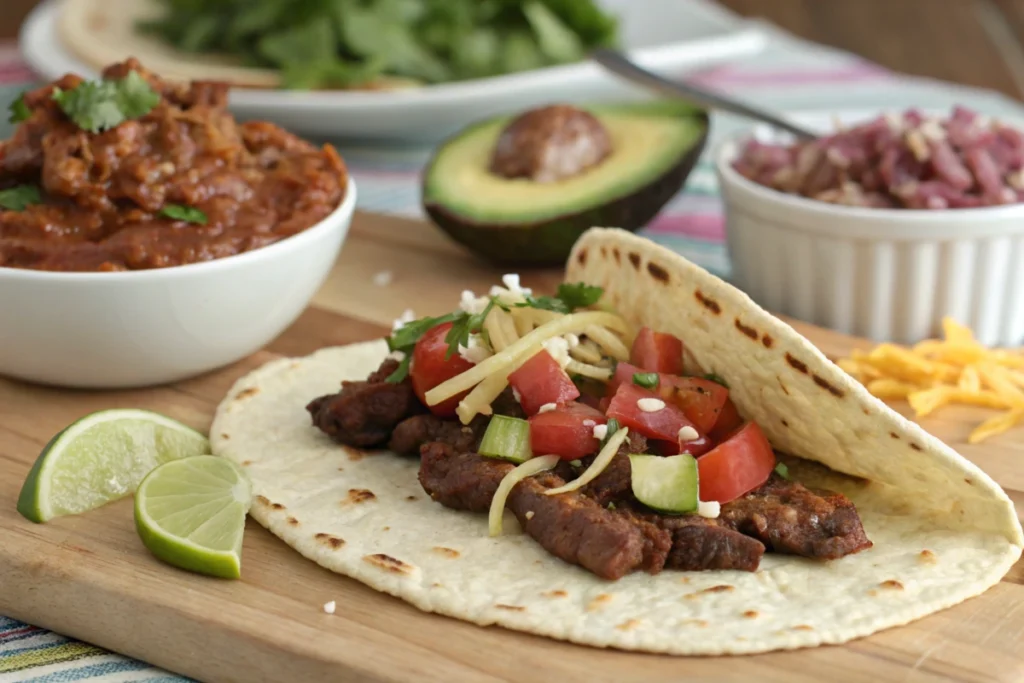
Here are the key layering steps to keep everything together:
- Warm tortilla base
- Thin spread of refried beans (optional)
- Seasoned protein
- Shredded cheese
- Crisp vegetables
- Sauces and garnishes
Preventing shell breakage
Shell cracks can mess up your taco’s look, but you can avoid them easily. Heat your shells in a 200°F oven before you put them together. The heat activates natural oils that make shells flexible and stronger. Here’s a pro tip for hard-shell tacos: melt cheese along the bottom first – it creates a reinforcing layer that reduces breaks by a lot.
Strategic filling distribution
You’ll become skilled at spreading fillings once you know how to balance your taco’s beauty and function. Spread meat along the shell’s sides instead of piling it at the bottom. This spreads the weight evenly and stops everything from falling out the bottom.
Smart Ingredient Placement Tips:
- Keep wet ingredients away from the tortilla so it stays crisp
- Put shredded lettuce or cabbage on top to hold other ingredients in place
- Use sour cream or guacamole as binding agents where needed
Odd numbers of tacos on your street taco plate create better visual appeal. This makes everything look better while keeping your taco structure solid. Note that good taco plating isn’t just about looks – it’s about building something that stays together until the final bite.
Choose the Perfect Plating Surface
A great taco presentation begins with the right serving surface. Your choice of plating can transform a casual meal into a unique dining experience.
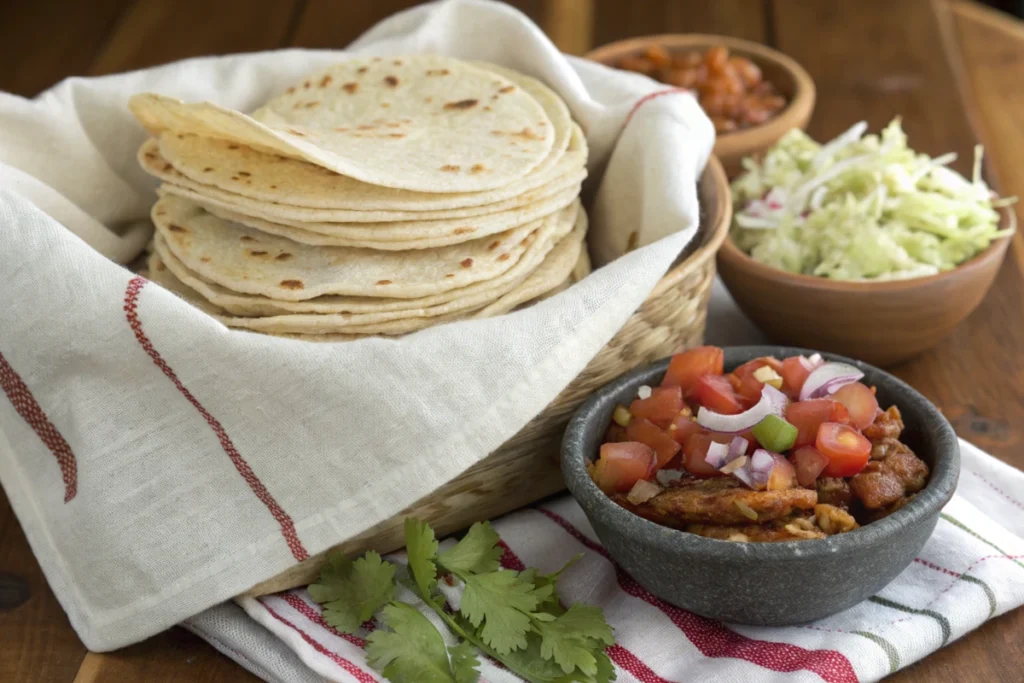
Traditional vs modern serving vessels of taco plate
Traditional ceramic plates bring timeless appeal, while contemporary options like metal taco holders create an industrial look. Faux wood boards with raised edges blend both worlds. These boards prevent sliding and keep their rustic charm. Modern taco bars feature compartmentalized serving platters that keep ingredients well-organized and available.
Material considerations for temperature
Your serving vessel’s material plays a vital role in keeping tacos at the right temperature. Here’s what you should know about different materials:
- Stoneware and ceramic: These materials retain heat exceptionally well when pre-warmed
- Metal surfaces: They keep temperature steady and you can put them in the oven
- Melamine: It’s lightweight but doesn’t hold heat well
- Acacia wood: This natural material stays food-safe but needs hand washing
You’ll get the best temperature control by warming your plates before serving. Stoneware plates can go in the oven or warming drawer to keep tacos perfectly heated.
Size and capacity guidelines for taco plate
Your taco plate should balance function and style. Standard taco holders fit two to three tacos, while larger platters hold up to eight tacos with room to spare. Family-style serving needs platters with enough space between tortillas. This extra room helps guests keep their hands clean during self-service.
Smart Plating Tips:
- Food-safe liners stop sliding and make cleanup a breeze
- Plates with slightly sloped rims contain any spills
- Reversible holders work great for both soft and hard shell tacos
The perfect plating surface lifts presentation and makes dining more enjoyable. Your choice of serving vessel sets the mood whether you’re having a casual taco Tuesday or an upscale dinner party.
Create Visual Balance and Symmetry for taco plate
Your taco plate serves as a canvas for culinary creativity, just like artists work with their medium. The visual appeal transcends simple arrangement and creates a harmonious composition that entices diners before their first bite.
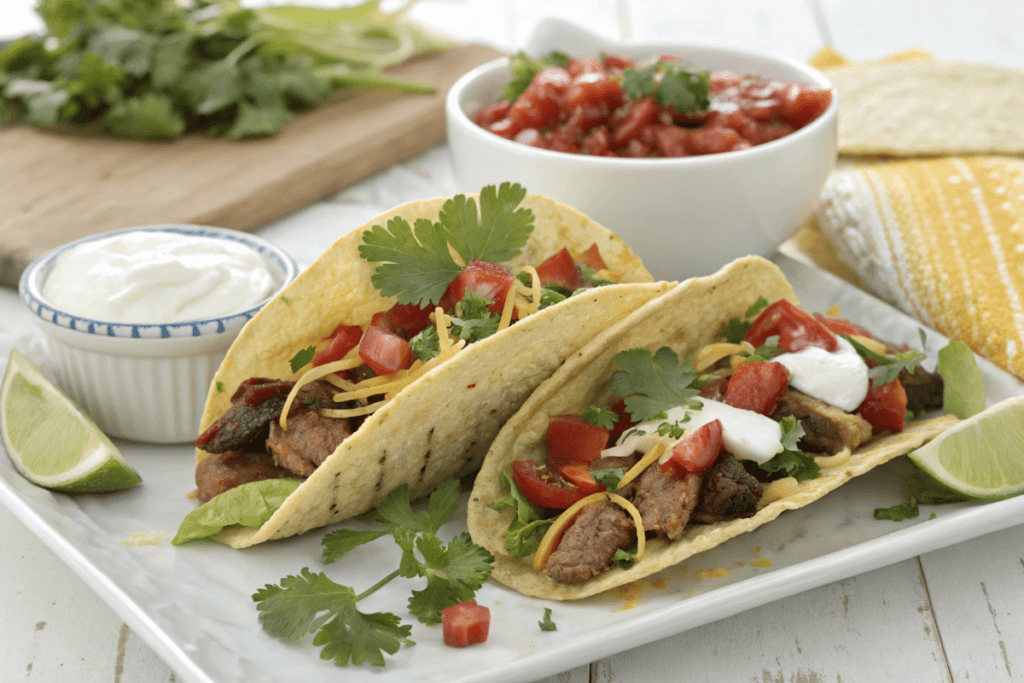
Color composition principles
A painter’s approach works best when plating tacos, with fresh ingredients serving as your palette. Striking contrasts emerge from red tomatoes, green cilantro, and purple cabbage that make your tacos stand out visually. Your taco plate can feature these vibrant combinations:
- Bright salsas against creamy white queso
- Fresh herbs among golden-brown tortillas
- Colorful vegetable garnishes against neutral proteins
The eyes taste first. Clean, attractive serving dishes that complement your theme will showcase these colors effectively.
Height variation techniques
Dimension enhances your taco presentation through different levels. Risers or stands at varying heights create an interesting visual display and make it easier for guests to reach all options. Open-face tacos placed at different angles create natural height variation for family-style serving.
Layering different components adds depth and visual interest to your dish. You can stack ingredients or arrange them in overlapping patterns to guide the eye across the plate. This approach makes your presentation more dynamic while looking impressive.
Negative space utilization
The empty areas around your tacos – negative space – matter as much as the food itself. Grouping tacos off-center or diagonally creates breathing room that draws attention to your culinary creation.
Thoughtful positioning of food on the plate, with attention to angles and curves, produces professional-looking results. This deliberate use of space prevents a cluttered or overwhelming presentation. Odd-numbered taco arrangements create more visually appealing compositions.
Pro Tip: Strategic placement of colorful salsas and garnishes around your tacos maximizes impact. The negative space creates natural breaks between different plate elements.
Balance doesn’t require perfect symmetry. Slightly offset taco arrangements maintain overall plate harmony while creating interest. This approach keeps your presentation naturally artful without appearing contrived.
Perfect Your Garnishing Game
A good garnish takes your taco plate from simple to extraordinary. It adds a professional touch that makes diners pause to admire before diving in. Each garnish should enhance both visual appeal and flavor while remaining completely edible.
Essential garnish combinations
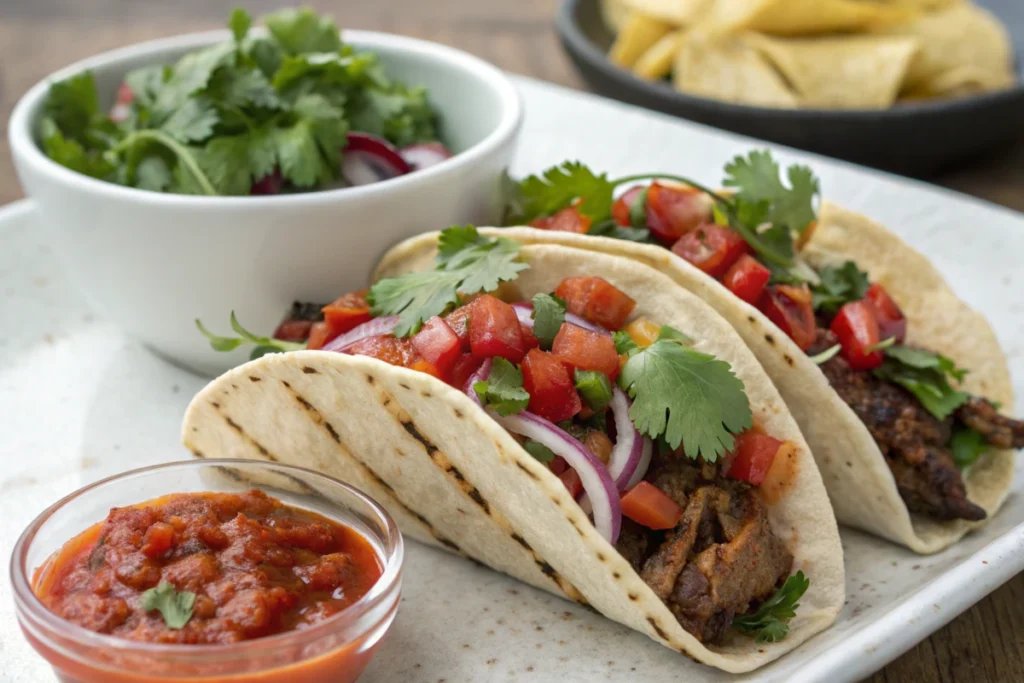
Successful garnish combinations balance colors, textures, and flavors perfectly. Traditional Mexican tacos showcase white onions, cilantro, and sliced radishes with a lime wedge. These proven combinations work great for a contemporary approach:
- Fresh herbs (cilantro, Mexican oregano) with pickled vegetables
- Citrus wedges paired with microgreens
- Cabbage slaw with radish slices and pickled onions
- Crema drizzles with fresh herb sprinkles
Edible decoration techniques
Your garnishing technique must balance presentation and practicality. Temperature and timing play crucial roles in garnish preparation. Some elements need to stay crisp while others taste best at room temperature. The perfect garnish preparation includes:
- Slice citrus wedges uniformly for consistent presentation
- Chop herbs just before serving to maintain freshness
- Create quick-pickled onions ahead of time for color and tang
- Prepare crema or sauces in squeeze bottles for precise drizzling
Strategic garnish placement
Your taco plate serves as a canvas where placement of each garnish matters. Larger elements like cabbage or lettuce form the base layer, followed by smaller garnishes on top. Temperature-sensitive items like crema or guacamole should be added last to maintain their consistency and prevent melting.
Pro Garnishing Tips:
- Position citrus wedges within easy reach for squeezing
- Arrange pickled elements to provide color contrast
- Keep wet garnishes separate from crispy elements
- Use odd numbers of garnish elements for visual appeal
Note that garnishes should complement your taco plate without overwhelming it. A well-executed garnish game lifts your street taco presentation while enhancing the overall dining experience. The garnishes should interact harmoniously with your main ingredients in flavor and temperature.
Purple cabbage slaw and bright citrus segments work beautifully with fish tacos. Fresh radishes and pickled onions cut through the richness of meat-based tacos while adding visual appeal. Each garnish should be fresh, properly prepared, and strategically placed to achieve both beauty and function.
Master Temperature Management
The right temperature can make your taco presentation perfect or turn it into a disappointing mess. You need to master hot and cold zones on your taco plate to ensure every bite stays delicious.
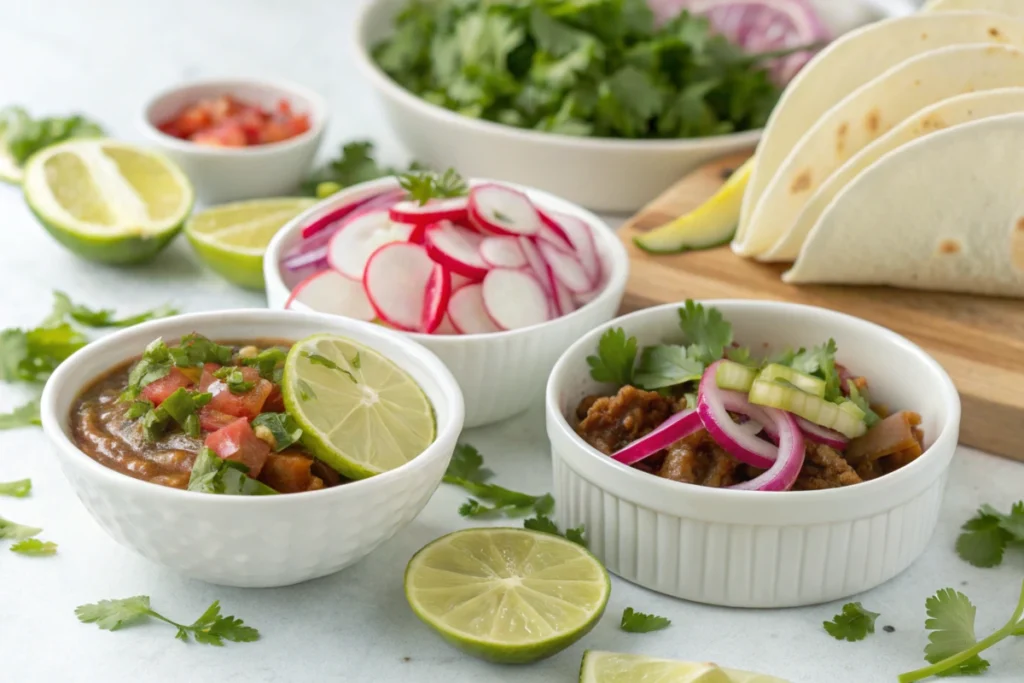
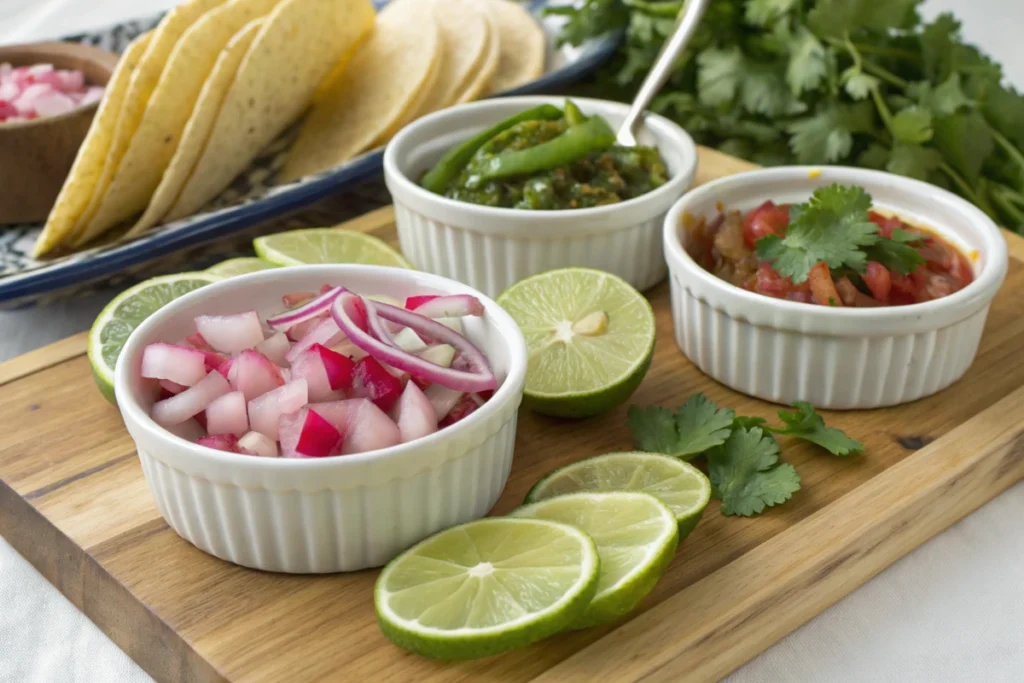
Hot and cold zones on the plate
Your taco ingredients need specific temperature ranges to stay safe and tasty. Hot ingredients like meats and beans should stay above 135°F. Cold items such as lettuce, tomatoes, and sour cream must stay below 41°F. The best way to handle this is to create distinct zones on your taco plate.
To handle hot components:
- Use chafing dishes or slow cookers to keep meats and beans warm
- Keep tortillas at serving temperature with foil wrapping
- Place hot items away from cold garnishes
Keeping components fresh
Storage plays a vital role in your ingredient’s quality. Wrap tortillas in foil and a damp dish towel to keep them warm and flexible. Cold items need an ice bath system – put bowls of sour cream and guacamole in larger containers filled with ice.
A slow cooker works great for multiple guests with these settings:
- Set to warm mode for tortilla storage
- Use damp towel wrapping to retain moisture
- Bring out small batches as needed
- Check temperature often
Timing your assembly
Perfect taco plating depends on your assembly timing. Heat tortillas on a comal or skillet first to boost their flavor and flexibility. Your cooking surface should stay at 350-375°F to work best.
The order of assembly matters substantially. Start with hot components at their peak temperature. Add room-temperature items next and finish with cold toppings right before serving. This method stops temperature transfer between ingredients and keeps your taco plate looking great.
Temperature Management Tips:
- Use a thermometer to check hot foods stay above 135°F
- Get fresh ice baths every two hours for cold items
- Keep extra ingredients ready at proper temperatures
- Use insulated containers for rice and sides
Note that timing makes a big difference. Toppings can stay out for up to two hours without temperature control, but it’s better to set them out just before eating. For bigger parties, bring fresh ingredients from the kitchen regularly to keep serving temperatures ideal.
Conclusion
Taco plating might look complex with its multiple elements – from proper layering and temperature control to artistic presentation and garnishing. These five simple techniques will reshape the scene of your taco game and take it from simple to exceptional.
Successful taco plating creates harmony between form and function. Well-laid-out layers prevent messy spills, while thoughtful garnishing and proper temperature zones make each bite burst with flavor. Smart plating choices and visual composition elevate simple tacos into stunning culinary presentations.
The best approach is to implement one technique at a time. Master proper layering and temperature management first. You can then add advanced elements like creative garnishing and artistic presentation gradually. Your taco plates will soon match professional kitchen standards, and every taco night will become a memorable dining experience.
FAQs
Q1. What’s the best way to layer ingredients in a taco? Start with a warm tortilla, then add a thin spread of refried beans (optional), followed by your protein, shredded cheese, crisp vegetables, and finally sauces and garnishes. This layering helps maintain stability and prevents the taco from falling apart.
Q2. How can I prevent my taco shells from breaking? Heat your taco shells in a 200°F oven before assembly to make them more flexible. For hard shells, try melting cheese along the bottom first to create a reinforcing layer that reduces breakage.
Q3. What are some essential garnishes for tacos? Classic garnishes include fresh cilantro, diced onions, and sliced radishes with a lime wedge. For a modern twist, try combinations like pickled vegetables with fresh herbs, citrus wedges with microgreens, or cabbage slaw with pickled onions.
Q4. How do I maintain proper temperature for taco ingredients? Keep hot ingredients like meats and beans above 135°F using chafing dishes or slow cookers. Cold items such as lettuce and sour cream should remain below 41°F. Create separate hot and cold zones on your serving platter to maintain these temperatures effectively.
Q5. What’s the secret to creating visually appealing taco plates? Use a variety of colors in your ingredients and garnishes. Play with height variation by using risers or stands. Utilize negative space on the plate by grouping tacos off-center or diagonally. Arrange tacos in odd numbers for a more visually pleasing composition.


1 thought on “5 Essential Tips for Crafting the Perfect Taco Plate”